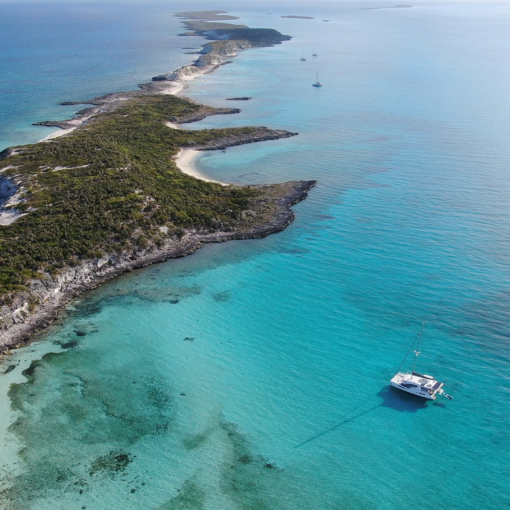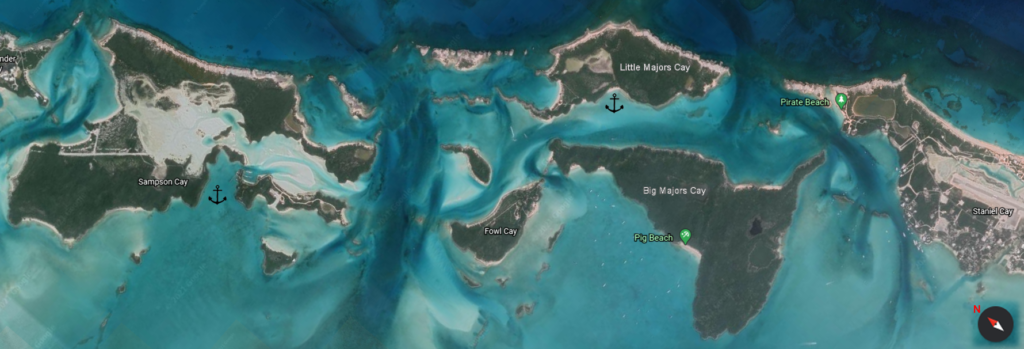
A pair of fronts were coming only days apart, the first delivering a moderate northerly and the second delivering the biggest blow since we arrived in the Exumas – and from the west! We left Compass Cay and returned to the more familiar Staniel Cay area.
Front One – 30 Knots North
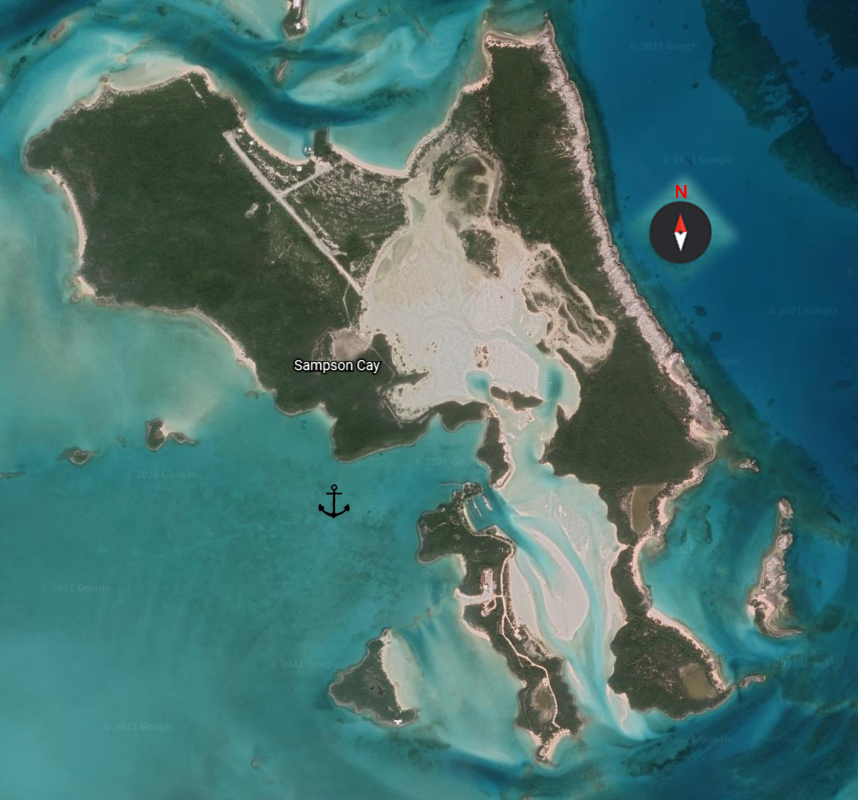
Sampson Cay lies just north of the Bay of Pigs. It is an anchorage we had been eying long before going to Staniel Cay, and we had explored its white sand harbor and the amazing sandbars of its interior by dinghy. It had perfect protection for a north wind.
When we arrived, we found a small crowd. The bay into the now-closed marina is narrow, and there was a single-file line of boats all the way in to the far west end. While it would have been really interesting being tucked way in there, there was plenty of protection at the end of the line. The only downside was that the pure sand gave way to grass and we had to try a couple times before the anchor set.
The wind that night and next morning peaked in the mid 30s. It was a little rolly initially while we waited for the wind to clock from west to north, but overall not bad.
We stayed an extra day and watched the boats slowly leave until we were almost all alone.
Front Two – 40 Knots West
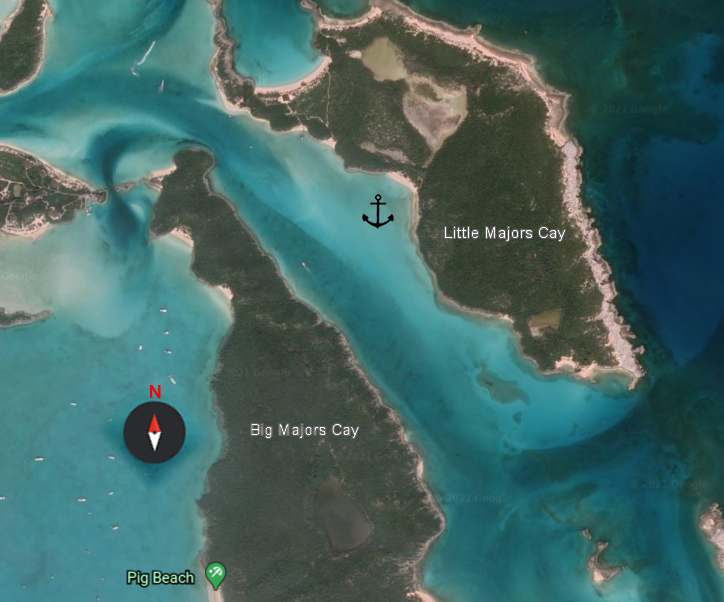
There are few options in the Exumas to hide from a westerly, and this was a long slow multi-day one progressing from east to south to a strong prolonged westerly. Unless we were prepared to move in the middle of that, we needed to find something suitable for any wind direction. And because there are few options, people were picking their spots early. We needed to hurry.
We decided that the “Between the Majors” anchorage, on the other side of Bay of Pigs, was our best bet. We left Sampson mid morning and took the short back route to the north and across the cut. This was mid tide. We were surprised by the current in the cut, but it seemed manageable. That is, until we went to cross the backside of Fowl Cay Resort. It was my first experience with what strong confused currents could do. There was a 100 foot section where the current would hit us on the beam (on our side) and it churned like the eddy currents I’ve seen in rivers. As soon as we hit it, the boat immediately turned 45 degrees and slid sideways. Our big boat was taken like a leaf. We had rocks to starboard and sand to port. Not wanting to see how this would play out, I gunned the engines and threw the wheel to port, making a quick 180 and an adrenaline filled exit.
Plan B was to head to Georgetown, so we started south and then checked the Georgetown conditions. Yikes! The Exuma Sound near Georgetown had 5 foot waves on 6 second intervals. No thank you.
Plan C quickly became a return to Between the Majors, via Staniel Cay Yacht Club, at low slack coming up in a couple hours. That worked, though crossing the big rolling waves at Big Rock Cut was an exciting couple minutes we wouldn’t like to repeat. Think big waves coming at you on the right and a big rock on your left. I can still hear the echo of Brenda’s “we’re going to die!” She felt better when an hour later we witnessed a monohull attempt it, bounce violently for 10 minutes as they tried to fight it off, then finally surrender and retreat.
Even though the heart of the storm wasn’t for another two days, the usually empty anchorage was already filling up. Fortunately for us, it was mostly monohulls who had to stay center-channel for depth. We picked out the sandy beach area and squeezed into the side of the line. It was a tight squeeze and we had a nervous night as boats moved randomly in the current. At one point the next morning, we were 20 feet from our friendly neighbor who told us in the nicest possible way that this was making them nervous. We agreed! We pulled up and moved closer to the beach. Now there was plenty of room. Plenty of room horizontally, but not vertically. We touched bottom that night.
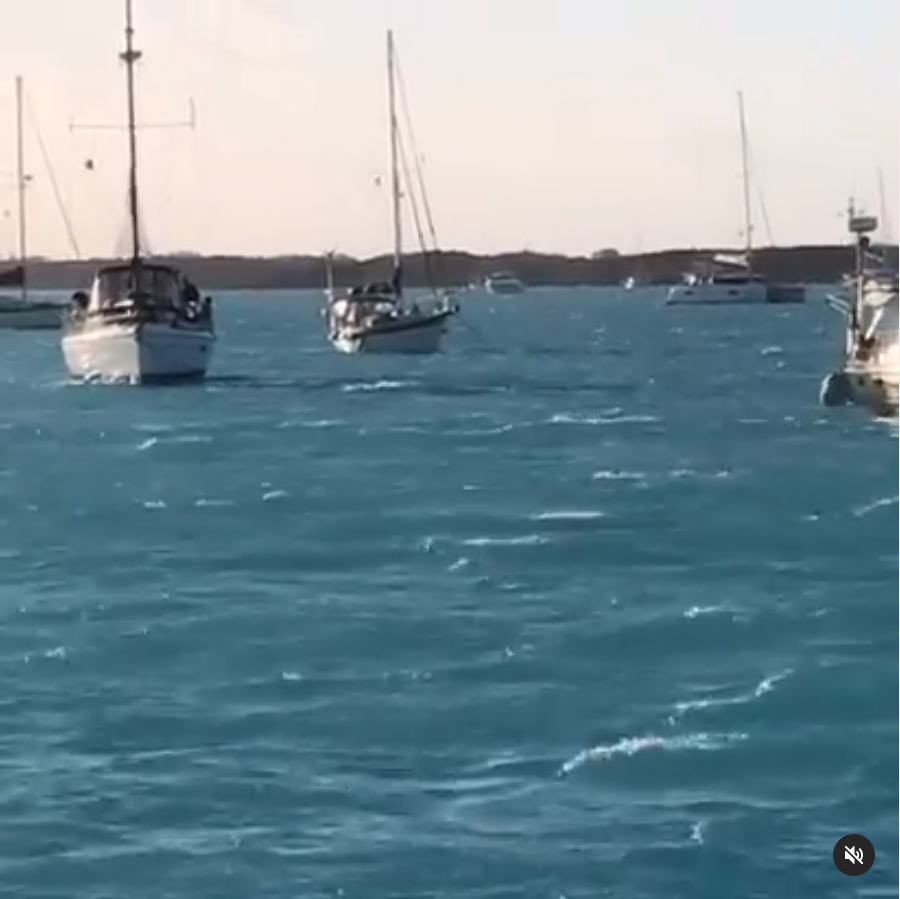
At sunrise we were surprised to see that the other nearby monohull was now on the far side of the channel! Did they move? Did they have hundreds of feet of chain out? We quickly learned they also hit bottom in the night, and moved at 2am. Impressive. Karma had smiled upon us. We moved again, taking advantage of the new space. We were no longer in danger of hitting nearby boats, but we still had shallow sand behind us. We were forced to ride the storm with only 65 feet of chain to the bridle, a 5:1 scope. Our friendly neighbor had 100 feet. Still, we felt confident because the anchor had fully disappeared into the sand, handle, roll bar and all.
More boats had been arriving, primarily filling the entire length between the Majors, most of which is not advertised as anchorage area due to poor holding. We saw one trawler spend half an hour trying and trying and trying to set their anchor before finally succeeding.
The front itself was strong, peaking around 40 knots. It was impressive seeing the long line of boats rocking in every direction. It’s not all sun, sand and cocktails out here, but it’s always an education. In hindsight, we were happy to have learned a lot.



